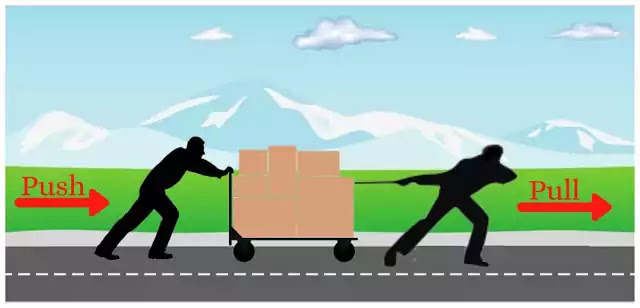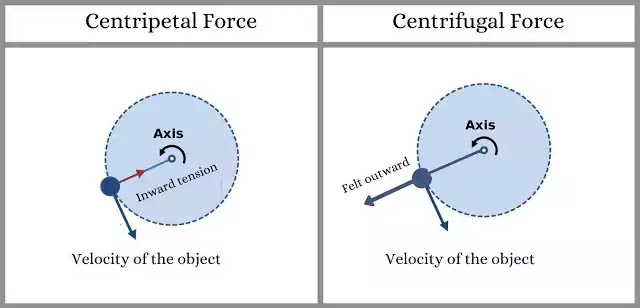From ancient times many philosophers have used the concept of force in the study of stationary and moving objects and simple machines, but thinkers like Aristotle and Archimedes retained the fundamental errors in understanding what is force. According to Aristotle, a force is anything that causes an object to undergo “unnatural motion”. After that most misconceptions about motion and force were finally corrected by Galileo Galilei and Sir Isaac Newton. Know more from Galileo's laws of inertia.
Here in this article, we are going to discuss some basic things about the force - that what force is, types of forces, and more about it. Below is a table of contents of what you will know from this article.
• What is force?
• How force is measured?
• What is balanced and unbalanced force?
• What is the net force?
• What is the push and pull action of force?
• What are the types of forces?
• What is frictional force?
• What is centripetal and centrifugal force?
• What are the fundamental forces of nature?
What is force?
In physics, a force is something physical cause that can changes either the size or shape of an object or changes the state of rest or the state of motion of the object. For example - if we press a soft rubber ball from two sides, its shape changes, or on stretching a rubber string, its length increases. And if we push a book lying on a table the book gets displaced.
A force is a vector quantity, so it has a magnitude and a direction. The direction in which the force is applied is known as the direction of the force and the application of force is the point where force is applied.
The force is measured by using the instrument called spring balance. The SI unit to measure force is Newton(N) and the CGS unit to measure force is dyne.
How force is measured?
We get the idea of the force from Newton's first law of motion but it is measured from Newton's second law of motion. According to the second law of motion when we exert a force on an object the rate of change in its momentum is directly proportional to the applied force on it. i.e
Where, P = momentum of the object, m = mass of the objects, v = velocity of the object, a = acceleration of the object
Using this formula we can measure the force applied to the object.
What is balanced and unbalanced force?
We know that force is a vector quantity, which means it has both magnitude and direction. Based on this magnitude of the force and the direction of the force the balanced force and unbalanced force can be defined.
Balanced force:
Balance forces are two forces acting on an object with the same magnitudes and opposite directions. When two people exert the same force on an object from opposite directions then the object is in the equilibrium state. This is an example of balanced force.
Unbalanced force:
Unbalance forces are two forces acting on an object with different magnitudes and opposite directions. When two people exert two different magnitudes of force on an object from opposite directions then the object is in a non-equilibrium state. This is an example of an unbalanced force.
Unbalanced force can cause a still object to move, moving object to speed up or slow down, moving object to stop, and moving object to change direction.
What is the net force?
The net force is the sum of all the forces acting on an object. This net force is the cause of the acceleration and equilibrium state of an object. As in the example of the balanced force above, the object is in an equilibrium state because the net force is zero. But in the example of the unbalanced force above, because the two forces with differents magnitudes applied from opposite directions the net force is not zero, which produces acceleration to the object.
This net force can be calculated using this formula where a significant number of forces are working on an object.
Where, F1, F2, F3…Fn are the forces that are acting on the object.
What is the push and pull action of force?
Sometimes force is simply defined as a push or pushing action and pull or pulling action with an object.
Push or pushing action of force:
When you apply a force against an object, if the object moves away from you then it is said to be the push or pushing action of the force. For example - When you push against a trolley car the car moves away from you, here the force that you apply is an example of a push force.
Pull or pulling action of force:
When you apply a force against an object, if the object moves towards you then it is said to be the pull or pulling action of the force. For example - When you pull a trolley car the car moves toward you, here the force that you apply is an example of the pull or pulling action of a force.
What are the types of forces?
According to the application, the forces can be classified into two categories - the contacts forces and the non-contact forces.
Contact forces:
Any kinds of forces that act on objects when they are in physical contact are called contact forces. For example - reaction force, tension force, frictional force. When these forces are in action they act on the object with physically in contact. That is why they are contact forces.
Non-contact forces:
Any kinds of forces that act on objects when they are not physically in contact are called non-contact forces. For example - gravitational force, electrostatic force, magnetic force. When these forces are in action they always act on an object from a distance. That is why they are non-contact forces. We will know the details about all these forces ahead.
What is frictional force?
When a surface moves or tries to move relative to another surface, the force that is exerted to the surface by the other surface is called the force of friction or the frictional force. The frictional force always acts opposite to the motion of the objects.
This frictional force depends on many factors such as it depends on the nature of the surface, the angle and position of the object, and many more things. Know more about frictional force...
What is centripetal and centrifugal force?
Centrifugal force, we experience it in different ways in our daily lives, such as when children ride on a merry-go-round, when we drive the car on a circular path or when an airplane banks into a turn, etc. But sometimes the centrifugal force is confused with its fellow centripetal force because they are very closely related. So, here is a brief discussion of these two types of forces.
Centripetal force:
Centripetal force is a type of force that keeps an object moving in a circular path where the direction of this force always acts toward the center of rotation. The centripetal force is an actual force. For example, when we rotate an object with a string, the string exerts an inward centripetal force on the object.
Centrifugal force:
Centrifugal force is an apparent force that is felt by an object moving in a circular path where the direction of this force acts outwardly away from the center of rotation. The Centrifugal force is an apparent force. In the above example, when we rotate an object with a string, the object appears to exert an outward centrifugal force on the string.
What are the fundamental forces of nature?
In this universe, there are various types of interactions are occurring between the particles. When we studied very closely the mechanism of the interactions between these particles, we find that these interactions can be divided into four fundamental forces.
These four fundamental forces are like this -
1. Gravitational force
2. Electromagnetic force
3. Strong nuclear force
4. Weak nuclear force
Gravitational force:
If gravitational force is to be talked about, then it is the weakest force of the four fundamental forces, but its region is the most. For this gravitational force, the planets rotate around the sun and the satellites orbit the planets.
Electromagnetic force:
Now if we talk about Electromagnetic force, it would not be too difficult for us to understand because now we are experiencing it in our daily life. Yes, I'm talking about electric and magnetic forces.
For a long time, electric and magnetic forces were considered as two separate forces. But in 1864, James Clerk Maxwell has unified these two forces through his Maxwell equations. Then in 1940, it becomes part of quantum mechanics due to quantum electrodynamics.
Strong nuclear force:
If we talk about the Strong nuclear force, then it is the strongest force among the four fundamental forces. This is because it holds the neutrons and protons in the nucleus of the atoms.
You can estimate its strength by helium (He) atom, which has two positively charged protons in the nucleus. positively charged particles naturally repel each other, so it takes an extreme amount of force to hold protons together.
The strong nuclear force overcomes the repulsion between protons to hold together atomic nuclei. Without a strong nuclear force, a complex nucleus cannot form.
Weak nuclear force:
The Weak nuclear force is also strong enough but its region is very small. Its mechanism of interaction occurs between subatomic particles that are responsible for the radioactive decay of atoms. For example, a phenomenon like beta decay is caused by this type of nuclear force.






Post a Comment (0)